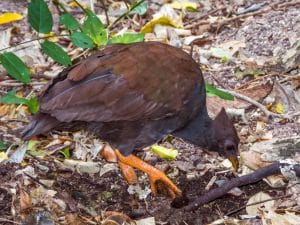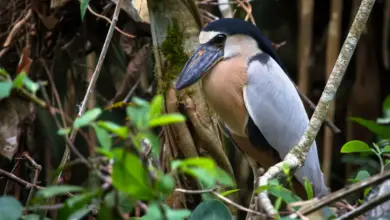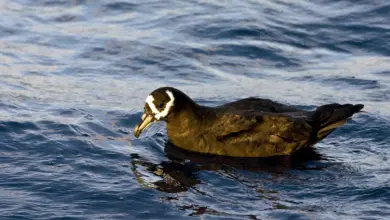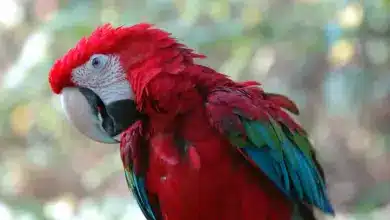Orange Footed Scrubfowl
Orange Footed Scrubfowl (Megapodius Reinhardt)
The Orange Footed Scrubfowl (Megapodius Reinhardt) is a large, ground-dwelling bird found in northern and eastern Australia. It is notable for its striking orange legs and feet and its habit of building large nesting mounds of plant material and soil.
Scrubfowls belong to the family Megapodiidae and are unique among birds for hatching their eggs using external heat sources rather than incubating them with body heat. The orange-footed scrubfowl is a unique bird native to Australia that is best known for its unusual nesting habits.
This megapode species has several distinctive features and behaviors that enable its uncommon approach to incubation and rearing young.
Orange Footed Scrubfowl Description and Identification
Orange Footed Scrubfowls are stocky birds standing around 40-46 cm tall and weighing 540-880g. Their plumage varies across their range but is generally colored grayish-brown above with paler underparts. The wings have rufous primary flight feathers, which are obvious in flight. The tail is rounded. As their name suggests, their legs and feet are bright orange-red. The stout bill is pale gray.
Male and female scrubfowls are similar in appearance, but males tend to be slightly larger. Immature birds have duller plumage overall, with less contrast between the upperparts and underparts. The orange feet are also paler in younger birds.
Several features distinguish Orange Footed Scrubfowl from other Megapodiidae species in Australia. The Red-billed Brush Turkey has a bright red bill and darker legs, while the Australian Brush Turkey has yellowish legs and feet. No other scrubfowl in Australia has such brightly colored orange legs and feet.
Orange Footed Scrubfowl Geographic Range and Habitat
Orange Footed Scrubfowls are endemic to Australia, found across northern coastal and sub-coastal regions from the Kimberley in Western Australia across the Top End of the Northern Territory to Cape York Peninsula. Their range extends down the east coast of Queensland as far south as Rockhampton.
The birds inhabit various habitats across their extensive range, typically open forests and woodlands with dense understory vegetation. They are found in monsoon forests, vine thickets, Melaleuca woodlands, mangroves, and along the edges of rainforests. The availability of areas to build nest mounds limits their distribution.
Orange Footed Scrubfowl Unique Nesting Habits
One of the most fascinating aspects of Orange Footed Scrubfowls is their incredible nesting behavior. They build large nesting mounds made of plant material, soil, and debris in open areas away from trees. Mounds are reused and added to year after year, and some very old mounds can reach heights up to 5 meters and widths of 12 meters!
The mounds provide a heat source for incubation. As the organic material in the mounds decomposes, they generate enough heat to incubate the eggs, so the adults do not directly brood the eggs. Each layer of freshly added material helps ramp up the temperatures. Nests can maintain temperatures of around 34°C, perfect for egg development.
Females lay between 2-5 eggs in chambers dug into the top of the mound. The white eggs measure about 60 mm long by 45 mm wide and weigh around 130 grams. Once the eggs have been laid, the parents do not provide any further care. After about 50 days of mound incubation, the highly precocial chicks hatch and dig themselves out of the nest mound.
Orange Footed Scrubfowl Diet and Feeding Behavior
Orange Footed Scrubfowls are omnivores, feeding opportunistically on various plant and animal matter. Their diet includes seeds, fruits, roots, tubers, fungi, insects, small reptiles, and amphibians. With their strong legs and feet, they energetically rake through leaf litter, searching for prey.
The birds play an important ecological role through their feeding habits. By turning over large amounts of forest floor material, they expose soil and distribute fungal spores and plant matter. They also help control insect and small vertebrate populations. Their nest mounds also facilitate seed germination, providing open nutrient-rich areas for plants.
Orange Footed Scrubfowl Threats and Conservation Status
Orange Footed Scrubfowls occur mainly in natural habitats and remote regions, facing relatively few major threats across most of their range. However, habitat loss from land clearing presents a risk in some areas, especially in southern Queensland, where coastal forests have been extensively cleared.
Introduced predators like cats and foxes take eggs and young chicks. In some regions, the birds are hunted for food. Collisions with vehicles can also cause mortality when roads cut through their habitat. Overall, however, Orange Footed Scrubfowl populations remain fairly stable. Their conservation status is currently Least Concern on the IUCN Red List.
Interesting Facts About The Orange Footed Scrubfowl
- Orange Footed Scrubfowls are one of around 50 species from the family Megapodiidae, all of which incubate their eggs using environmental heat sources rather than body heat. This family of birds is unique for having abandoned true incubation.
- The large mound nests provide ideal incubation conditions. Temperatures usually fluctuate between 30-36°C, high enough for successful incubation. Researchers have found that mound temperatures exceeding 36°C can negatively impact hatching success.
- Both the male and female Orange Footed Scrubfowl work together to build massive nesting mounds each breeding season. They use their strong legs and feet to rake up material into large piles.
- Old nest mounds are often reused for many years. The birds may have used estimated long-established mounds for over 60 years!
- If conditions are favorable with abundant food, females can lay multiple clutches in a single breeding season. Each clutch is laid in a separate chamber dug into the mound.
- The newly hatched chicks are independent and feed themselves right away while still in the nest mound. They will dig upward for 1-2 days before emerging at the surface.
- Young chicks can fly short distances from around two weeks old. But they remain dependent on their parents for food and protection for several months, never encountering true incubation.
- Orange Footed Scrubfowls are essential seed dispersers. Viable seeds from at least 24 plant species have been found germinating from their nesting mounds.
- The birds supplement their diet with grit to help grind up food in their muscular gizzard. They also ingest charcoal from burnt areas, which may help neutralize toxins.
Orange Footed Scrubfowl Conservation and the Future
Despite not facing any major threats currently, some conservation management could benefit Orange Footed Scrubfowls in the future:
- Protecting the remaining areas of intact coastal forest habitat will be important for ensuring nesting and foraging areas are retained.
- Monitoring known nesting colonies and mound sites will help maintain awareness of population trends over time.
- Controlling predators like feral cats in key habitat areas may improve nesting success.
- Working with local landholders to fence scrubfowl nesting habitat off from livestock can reduce trampling impacts.
- Further research on genetics and dispersal across different regions could identify isolated or unique populations needing protection.
- Raising public awareness about scrubfowl through environmental education programs will promote a wider appreciation for these unique birds and encourage conservation-minded behaviors.
- Developing captive breeding and release programs to reestablish scrubfowl populations in areas where they have been eliminated could aid future restoration efforts.
Orange Footed Scrubfowl Conclusion
With their communal incubator mounds, orange-footed scrubfowls exhibit some of the most unusual nesting behaviors in the avian world. Their ability to cooperatively maintain complex egg incubation structures relying solely on environmental heat sources is unparalleled.
These intriguing behaviors highlight the remarkable diversity and innovation in bird reproductive strategies. Protecting the scrubfowl’s tropical habitat will be key to preserving Australia’s mysterious mound-building birds.






